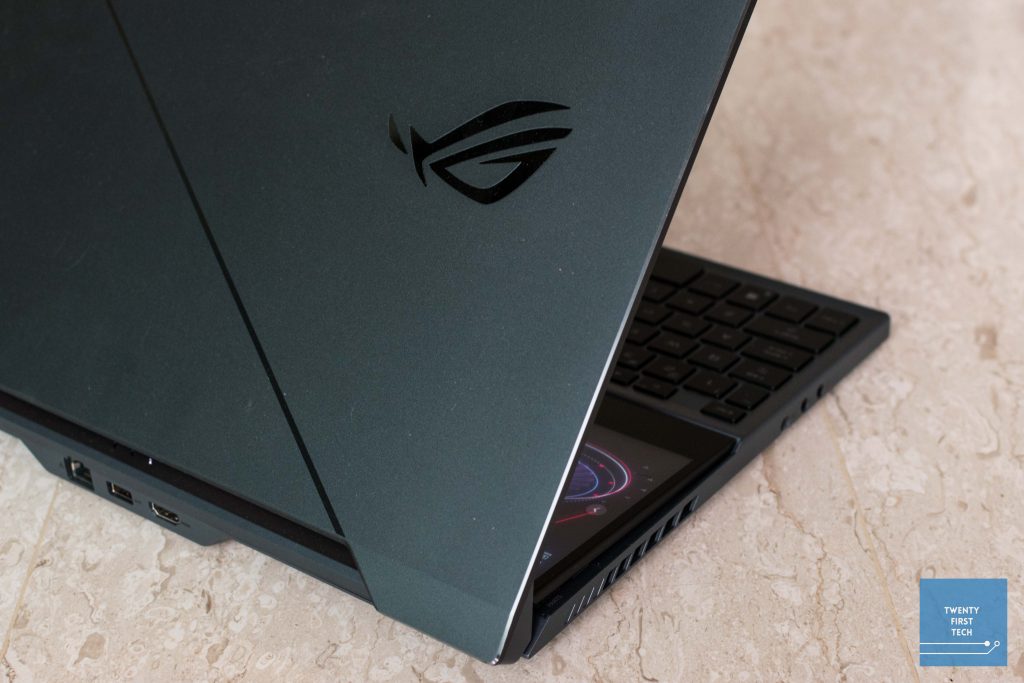The Duo 15 from ASUS has overkill specs and a novel second display. But is it any good? Find out in our ASUS ROG Zephyrus Duo 15 review.
The Duo 15 review unit that I have is a monster. A 300Hz display, 10th Gen Intel i9 processor, an RTX 2080 Super Max-Q, 32GB of DDR4 memory, and 2TB NVMe storage. Its price is equally as monstrous: S$6,998.
And the specs aren’t even the headlining feature of this device. As if all of that wasn’t enough, the Duo also has a secondary ScreenPad Plus display warranting its name.
There’s a lot to unpack here, but let’s start where we always do: the specs.
ROG Zephyrus Duo 15 Specifications
- 15.6″ Full HD 1920×1080 300Hz Display
- Intel® Core™ i9-10980HK Processor 2.4 GHZ (16M Cache, up to 5.3 GHz)
- 32GB DDR4 3200Mhz RAM
- 1TB + 1TB M.2 NVMe™ PCIe® 3.0 RAID0 SSD
- NVIDIA GeForce RTX 2080 Super Max-Q (8GB VRAM)
- Ports: 2x USB 3.2 (Gen 1) Type-A, 1x USB 3.2 (Gen 2) Type-A, 1x Type C USB 3.2 (Gen 2), HDMI, Ethernet, Mic in, Headphone jack
- 36.0 cm x 26.8 cm x 2.09 cm, 2.48 kg
- Misc: WiFi 6, liquid metal cooling
- In the box: McAfee + Gladius Mouse II + 240W Adapter + 64W PD Adapter + ROG Delta headset + Ranger Backpack + ROG EYE Webcam + Detachable palm rest
One thing you’ll notice is the amount of stuff that’s bundled together with the laptop itself. You get a gaming mouse, gaming headset, backpack, two AC adapters, and an external webcam. A representative from ASUS has told me that you aren’t able to buy the laptop on its own as the package is part of the ROG brand. I would have preferred an option to purchase the standalone laptop at a cheaper price.
Design & build
The Duo 15 has a rather novel build thanks to its second display. When opening the lid of the device, a hinge mechanism props up the second display at an angle for better visibility. The hinge is sturdy and does not move at all when pressing down on the display. This is important given that the second display is a touchscreen (the main display isn’t). However, there is some flex in the centre of the panel.
There are two consequences of the second display. Firstly, the keyboard had to be shifted down to accommodate it. This means that there isn’t a palm rest like on a regular keyboard. I didn’t find this to be much of an issue; if it does bother you, there is a detachable palm rest included in the box. Secondly, the chin on the main display is also much larger than most contemporary laptops. This is mainly an aesthetic issue, though I couldn’t help but wonder if they could’ve shifted the display down slightly to reduce the size of the chin and accommodate a webcam above; there isn’t a webcam on this device, though one is bundled in the box.
Other than these, the rest of the build quality is excellent. The brushed metal finish is premium and nice to the touch, while the chassis and lid feel extremely sturdy. I do wish that the barrel power plug was on the back rather than on the left side of the device as the cable does get in the way.
At 2.48kg, it is rather heavy and larger than most other 15″ laptops, but perhaps that’s the price that you have to pay for the secondary display and such monstrous specs.
Displays
The main panel on the Duo is a non-touch 15.6″ FHD display with 300Hz refresh rate and 3ms response time. The high refresh rate matched with top-end internals means that the Duo will be great for competitive gaming.
The display is also very colour accurate and is calibrated to the sRGB colourspace. There is a 4K option, but that’s 60Hz and tuned to Adobe RGB. Gamers should definitely go for the former while creatives would be more enticed by the latter.
The second display is touch screen and has a much wider aspect ratio. ASUS markets several use cases for the screen. When video editing for example, you could have your timeline on the secondary display. Certain games such as the upcoming Dying Light 2 (bundled with the device) can also display information such as missions and inventory on the second screen. Streamers will be able to have their streaming apps on the second display while reserving the entire main screen for gaming.
Personally, I hardly used the secondary display. Perhaps the only time I did was when I was monitoring the device usage stats while running a game, or looking up a YouTube tutorial in Chrome. That being said, while it isn’t for me, I’m sure many content creators, gamers and streamers will find the second display to be immensely useful.
The one thing that I do dislike about the second display is that you can no longer throw your mouse to the bottom of the screen to access the taskbar. Because of the bottom of the main display is linked to the top of the second display, doing so will now simply send your mouse into the second display. I found this to be rather annoying.
As a side note, the second display is actually at a higher resolution (3840 x 1100) than the main display (1920 x 1080), though the second display defaults to 1920 x 550 resolution to avoid any scaling inconsistencies.
Keyboard & trackpad
Typing on the keyboard is excellent. It’s got 1.4mm of travel which I feel is sufficient, and the switches are satisfying. One caveat is that as mentioned above, there is no palm rest due to the design of the device, though a detachable one is included.
The keys are individually RGB illuminated, and there are a ton of customisation options available on ASUS’ Aura Creator app. One thing to note is that the function numbers are not illuminated.
The trackpad is made of glass and tracks well. It is placed at a rather unconventional location at the right side of the keyboard, so that may be another thing that you’d have to get used to. It also doubles as a touch-enabled numberpad, and has physical right and left mouse keys which I appreciate on a Windows device.
Performance & battery life
Performance, as you can expect, is excellent. But on top of the raw specs, the Duo is also an incredibly well-cooled machine. Two fans under the second display draw in air which exhaust out the sides and back. Furthermore, the CPU is also cooled with liquid metal rather than conventional thermal paste. Thermal performance is thus excellent, though the device does run relatively hot even on idle.
It’s not easy to cool an Intel i9, so ASUS really did do a good job here. But once again I wish there was an AMD variant.
As for the performance, we ran some games on Ultra settings and measured the average frames per second (FPS), collated in the graph below. Most games are able to hit well above 60 FPS even on Ultra.

Battery life is as you’d expect from a device of this calibre, which is to say, not very impressive. I’ve been typing this review on Chrome with a game downloading in the background for about an hour and the battery has already gone down to 42%.
Of course, battery life depends on what you do with the device. If you’re doing intensive tasks like content creation I’d expect around 2 hours of battery life, while lightweight tasks might see the battery last around 4 hours.
If you’re planning on gaming or making the most out of the GPU, you have to carry the charging brick with you. This CPU-GPU combination is extremely power-hungry and cannot operate at their full potential running off of battery power.
One thing to note is that ASUS does provide two charging bricks in the box: a 240W one and a more portable 65W one that supports USB PD. This is great news as it offers more flexibility. If you’re taking your laptop out but you know that you won’t be using the GPU intensively, you can opt to bring the much smaller 65W charger instead. This charger can also be used to fast charge other devices like your Android phone.
Pricing & conclusion
Pros
- Excellent 300Hz/3ms display
- Top-end specs with good thermal performance
- Second display can be extremely useful to certain people
- Fantastic build quality and design
Cons
- Usual pitfalls of a monstrous gaming laptop: poor battery life, runs hot
- Has to be purchased as a bundle at S$6,998
- Keyboard and trackpad layout can take some getting used to
- No webcam, though external one is included
The Zephyrus Duo 15 is an overkill of a machine, and at S$6,998, you can probably get similar performance for much less. The Lenovo Legion 5i that I reviewed gives up just ~10 FPS on average on the games that I’ve tested and costs half the price.
To be fair, the Duo’s seven thousand dollar asking price is part of a bundle. I still wish however, that there is an option to get the Duo as a standalone purchase without the accessories. Not everyone wants a headset, mouse, or backpack bundled with their laptop as they might already own these things.
As a package, the Duo is probably the most expensive device that I’ve ever reviewed. Do I think it’s worth seven thousand dollars? Probably not. But if you have the money, want killer specs, and can actually make good use of the second display, I think you’ll be very happy with the Duo 15.
Of course, as with the Zephyrus G14 that I recently reviewed, the Duo 15 is also out of stock on the ASUS online store. ASUS has told me that there is currently no confirmation on when the device will be restocked, though the ROG store at Bugis can help with registration of interest.
As always, when purchasing online, check if you can get additional cashback on your purchase with ShopBack. You can also check out our deals page for more Singapore deals.
Liked this review? Follow us on Facebook, Twitter or Instagram for more updates!








